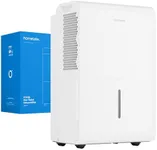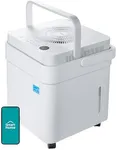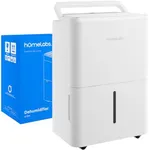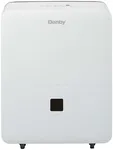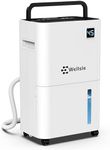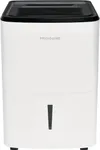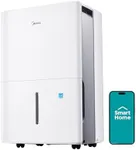Buying Guide for the Best Quiet Dehumidifiers
Choosing a quiet dehumidifier is all about finding a balance between effective moisture removal and minimal noise. Dehumidifiers are great for keeping your home comfortable and preventing issues like mold, but if you want one for a bedroom, nursery, or office, quiet operation becomes especially important. To make the best choice, you should understand the main features that affect both performance and noise, and match them to your room size and personal comfort needs.Noise Level (dB)Noise level, measured in decibels (dB), tells you how loud the dehumidifier will be when it's running. This is especially important if you plan to use the device in a bedroom, living room, or any quiet space. Lower dB values mean quieter operation. Generally, dehumidifiers can range from about 30 dB (very quiet, like a whisper) to over 60 dB (similar to normal conversation). For bedrooms or nurseries, look for models under 40 dB. For living areas, up to 50 dB may be acceptable. Always consider where you'll use the dehumidifier and how sensitive you are to background noise.
Capacity (Pints per Day)Capacity refers to how much moisture the dehumidifier can remove from the air in a 24-hour period, usually measured in pints. This is important because a unit that's too small won't keep up with moisture, while one that's too large may cycle on and off frequently, sometimes creating more noise. Small rooms (like bathrooms or closets) can use units with 20 pints or less, medium rooms (bedrooms, offices) may need 20-35 pints, and large spaces (basements, living rooms) might require 35 pints or more. Match the capacity to your room size and humidity level for the best results.
Fan Speed SettingsFan speed settings let you control how fast the dehumidifier runs, which directly affects both noise and moisture removal. More speed options mean you can choose a quieter, lower setting for nighttime or when you need less noise, and a higher setting for faster drying when noise is less of a concern. If quiet operation is a priority, look for models with multiple fan speeds or a dedicated 'quiet' or 'sleep' mode.
Auto Mode and HumidistatAn auto mode or built-in humidistat allows the dehumidifier to automatically adjust its operation based on the current humidity level. This means the unit only runs as much as needed, which can reduce noise because it won't be running at full power all the time. If you want a set-and-forget experience and less noise overall, look for this feature.
Size and PortabilityThe physical size and portability of a dehumidifier can affect where you place it and how easily you can move it between rooms. Smaller, more portable units are often quieter and suitable for bedrooms or small spaces, while larger units may be noisier but handle bigger areas. Think about where you need the dehumidifier most and whether you'll want to move it around.
Compressor vs. Desiccant TechnologyDehumidifiers generally use either compressor or desiccant technology. Compressor models are more common and powerful, but they tend to be noisier due to the motor and compressor. Desiccant models are usually quieter and lighter, making them a good choice for bedrooms or quiet spaces, but they may be less effective in very large or humid areas. Consider your noise sensitivity and the size of the space when choosing between these technologies.
